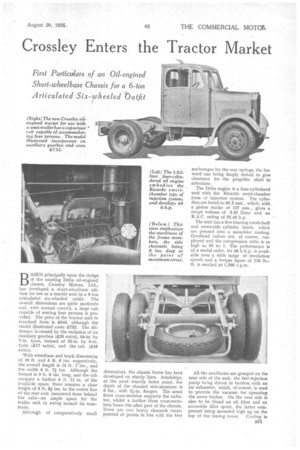Crossley Enters the Tractor Market
Page 27

Page 28

If you've noticed an error in this article please click here to report it so we can fix it.
BASED principally upon the design of the existing Delta oil-engined chassis, Crossley Motors, Ltd., has developed a short-wheelbase edition for use as a tractor unit in a 6-ton articulated six-wheeled mita. The overall dimensions are quite moderate and, with normal control, a large cab. capable of seating four persons is provided. The price of the tractor unit in standard form is £645, although the model illustrated costs £732. The difference is caused by the inclusion of an auxiliary gearbox (£25 extra), 34-in. by 7-in. tyres, instead of 32-in. by 6-in. tyres (£17 extra), and the cab (£45 extra).
With wheelbase and track dimensions of 10 ft. and 5 ft. 6 ins, respectively, the overall length is 15 ft. 7 ins., and the width 6 ft. 7f ins. Although the bonnet is 3 ft. 6 ins, long, and the cab occupies a further 4 ft. 1+ in. of the available space, there remains a clear length of 3 ft:81. ins, to the centre line of the rear axle (measured from behind the cab)—an ample space for the trailer unit to swing around its trunnions.
Although of comparatively small dimensions, the chassis frame has been developed on sturdy lines. Amidships, at the most heavily laden point, the depth of the channel side-members is 9 ins., with 21-in. flanges. The usual front cross-member supports the radiator, whilst a further three cross-members brace the after part of the chassis. There are two heavy channels incorporated at points in line with the two anchorages for the rear springs, the forward one being deeply dished to give clearance for the propeller shaft to articulate.
The Delta engine is a four-cylindered unit with the Ricardo swirl-chamber form of injection system. The cylinders are bored to 95.2 mm., which, with a piston stroke of 127 mm., gives a swept volume of 3.62 litres and an R.A.C. rating of 22.49 h.p.
The unit has a five-hearing crankshaft and renewable cylinder liners, which are pressed into a monobloc casting. Overhead valves are, of course, employed and the compression ratio is as high as 20 .to 1. The performance is of a useful order, for 48 b.h.p. is available over a wide range of revolution speeds and a torque figure of 136 lb.ft. is reached at 1,200 r.p.m.
All the auxiliaries are grouped on the near side of the unit, the fuel-injection pump being driven in tandem with an air exhauster, which, of course, is used to provide the vacuum for operating the servo brakes. On the near side is also to be found an oil filter and an accessible filler spout, the latter component being mounted high up on the top of the timing cover. Cooling is
effected by a large-capacity water pump, in conjunction with a fan, which is belt-driven from the auxiliary line.
In the standard Delta chassis, a single-plate Ferodo-faced clutch is coupled to a four-speed gearbox, the power thereafter being transmitted by a one-piece propeller shaft to the rear axle. In the particular chassis illustrated, however, an auxiliary gearbox is installed, which gives either a direct drive or a reduction of 1.96 to 1. Thus. the standardized ratios of 4.52, 2.7 and 1.67 to 1 for the indirect gears can be almost doubled in an emergency. The standard axle ratio is 7.5 to I.
The half shafts enclosed in the overhead-worm type of casing are fully floating, so that they are free from load other than the driving torque. As has already been mentioned, a servo mechanism is provided to assist the pedal application for all four brakes. The servo itself is of the MareIli type, the necessary depression for Its actuation being obtained from a powerexhausted container which is slung amidships across the chassis. All drums are 16 ins, in diarneter, the front shoes being 2i ins, wide, whilst those at the rear have a width of 4i ins. The hand brake operates the same shoes in the rear drums as the pedal and ff trip gear allows both systems to be operated independently.
Steering is by cam-and-roller mechanism, and the various links to the axle swivels are equipped with springloaded ball-and-socket joints. The standard equipment includes a starter. Other items of interest are the inclusion of a 12-volt 10-amp, dynamo, which is chain-driven from the front of the engine, and a 150-ampere hour battery. Mention should be made of the cab, for it is more than ordinarily well equipped. A divided windscreen with the Triplex toughened panels inclined to an obtuse-angled V, gives excellent vision all round. Vision is further enhanced by quarter lights built into the forward side panelling; winding windows in the doors ensure adequate ventilation.
The fully equipped facia board carries a speedometer, vacuum gauge, ammeter, lighting switches, oil gauges and so forth, grouped in a convenient manner. The battery is in an accessible position under the driver's seat.












































































